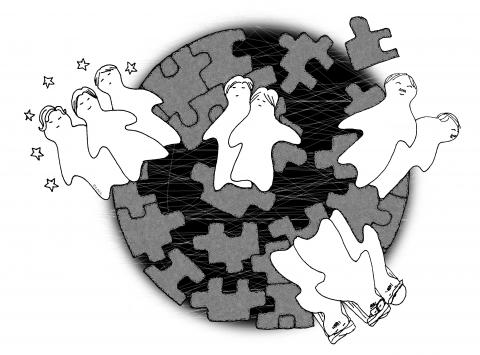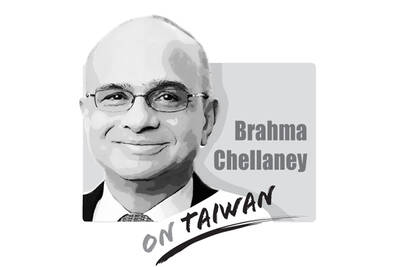At their recent summit in Cannes, the G20 shelved, if not buried, the WTO’s moribund Doha Development Round of multilateral trade negotiations. Crisis-weary Europe and America face a rising tide of protectionism at home and are trying to find ways to blunt the edge of China’s non-transparent trade competitiveness.
Turning his attention from the Atlantic to the Pacific, US President Barack Obama — with his eye, once again, trained on China — has now unveiled a new regional trade initiative. Why was the US unwilling to move forward on the Doha Round, but willing to pursue a regional free-trade agreement?
The answer lies in the fact that the Trans-Pacific Partnership (TPP), launched by Obama and the governments of eight other Pacific economies — Australia, Brunei, Chile, Malaysia, New Zealand, Peru, Singapore and Vietnam — is not just about trade.

While Obama chose to stick to the economic factors driving the TPP, US Secretary of State Hillary Rodham Clinton, on the eve of the just-concluded APEC gathering in Hawaii, laid out the initiative’s wider strategic context.
“The United States will continue to make the case that … [the region] must pursue not just more growth, but better growth,” which “is not merely a matter of economics,” Clinton said.
“Openness, freedom, transparency and fairness have meaning far beyond the business realm,” she continued. “Just as the United States advocates for them in an economic context, we also advocate for them in political and social contexts.”
Following up on these remarks, Obama drew attention to persistent US concern about China’s exchange-rate policy, inadequate protection of intellectual property and impediments to market access.
“For an economy like the United States — where our biggest competitive advantage is our knowledge, our innovation, our patents, our copyrights — for us not to get the kind of protection we need in a large marketplace like China is not acceptable,” Obama said.
The TPP initiative should be viewed against this background and not just in the context of the collapse of the Doha Round.
The TPP’s nine sponsors have resolved “to establish a comprehensive, next-generation regional agreement that liberalizes trade and investment and addresses new and traditional trade issues and 21st century challenges.”
These leaders also agreed to fast-track the TPP initiative and to consider opening it to other members — most importantly Japan, a late convert to the idea of a Pacific region free-trade agreement.
The TPP’s agenda is divided into three categories: core, cross-cutting and emerging issues. The core agenda is to stitch together a traditional free-trade agreement focused on industrial goods, agriculture and textiles.
The agreement would also have provisions for intellectual-property protection and what are dubbed the social and environmental issues. In short, the TPP’s core agenda will offer the region a Doha Round-type agreement that includes the social and environmental agenda that developing economies have been resisting within the WTO.
Going beyond the core, the cross-cutting issues include investor-friendly regulatory systems and policies that enable “innovative” or “employment-creating” small and medium-size enterprises to operate freely across borders within the TPP region.
Finally, the TPP seeks to bring into the ambit of a trade and investment agreement “new and emerging” issues. These include “trade and investment in innovative products and services, including digital technologies, and ensuring state-owned enterprises compete fairly with private companies and do not distort competition in ways that put US companies and workers at a disadvantage.”
In short, the US has moved to bring together all of the economies in the region that are worried about China’s beggar-thy-neighbor trade and exchange-rate policies. For the US, the eight other TPP countries, with a combined population of 200 million, constitute its fourth largest export market, behind only China, the EU and Japan. If Japan joins, the TPP’s importance would rise dramatically.
While the economics of the TPP is important, the strategic component is even more so. This is the second leg of the US’ new “Pacific offensive,” aimed at offering nations in the region an alternative to excessive and rapidly growing dependence on a rising China.
The first leg of the offensive was the idea of the “Indo-Pacific” region, which Clinton developed a year ago and followed up this year with an essay called “America’s Pacific Century.” There, she defines the new region of US strategic engagement as “stretching from the Indian subcontinent to the western shores of the Americas.”
Extending east from the Indian Ocean and west via the Pacific, the US is creating a new strategic framework for the 21st century.
The TPP is just one of the pillars of that new edifice.
Sanjaya Baru is director for geoeconomics and strategy at the International Institute of Strategic Studies.
Copyright: Project Syndicate

China badly misread Japan. It sought to intimidate Tokyo into silence on Taiwan. Instead, it has achieved the opposite by hardening Japanese resolve. By trying to bludgeon a major power like Japan into accepting its “red lines” — above all on Taiwan — China laid bare the raw coercive logic of compellence now driving its foreign policy toward Asian states. From the Taiwan Strait and the East and South China Seas to the Himalayan frontier, Beijing has increasingly relied on economic warfare, diplomatic intimidation and military pressure to bend neighbors to its will. Confident in its growing power, China appeared to believe
Taiwan-India relations appear to have been put on the back burner this year, including on Taiwan’s side. Geopolitical pressures have compelled both countries to recalibrate their priorities, even as their core security challenges remain unchanged. However, what is striking is the visible decline in the attention India once received from Taiwan. The absence of the annual Diwali celebrations for the Indian community and the lack of a commemoration marking the 30-year anniversary of the representative offices, the India Taipei Association and the Taipei Economic and Cultural Center, speak volumes and raise serious questions about whether Taiwan still has a coherent India
Recent media reports have again warned that traditional Chinese medicine pharmacies are disappearing and might vanish altogether within the next 15 years. Yet viewed through the broader lens of social and economic change, the rise and fall — or transformation — of industries is rarely the result of a single factor, nor is it inherently negative. Taiwan itself offers a clear parallel. Once renowned globally for manufacturing, it is now best known for its high-tech industries. Along the way, some businesses successfully transformed, while others disappeared. These shifts, painful as they might be for those directly affected, have not necessarily harmed society
Legislators of the opposition parties, consisting of the Chinese Nationalist Party (KMT) and the Taiwan People’s Party (TPP), on Friday moved to initiate impeachment proceedings against President William Lai (賴清德). They accused Lai of undermining the nation’s constitutional order and democracy. For anyone who has been paying attention to the actions of the KMT and the TPP in the legislature since they gained a combined majority in February last year, pushing through constitutionally dubious legislation, defunding the Control Yuan and ensuring that the Constitutional Court is unable to operate properly, such an accusation borders the absurd. That they are basing this